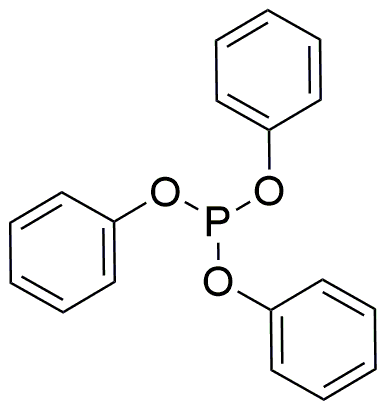Triphenyl phosphite is widely utilized in research focused on:
- Antioxidant Applications: This compound is often used as an antioxidant in plastics and polymers, helping to enhance their stability and longevity by preventing oxidative degradation.
- Pharmaceutical Synthesis: In the pharmaceutical industry, it serves as a reagent in the synthesis of various active pharmaceutical ingredients, improving yields and reaction efficiency.
- Flame Retardants: Triphenyl phosphite is incorporated into flame retardant formulations, providing enhanced fire resistance for materials used in construction and textiles.
- Stabilizers in Coatings: It acts as a stabilizer in coatings and paints, ensuring color retention and preventing deterioration from environmental exposure.
- Research and Development: In academic and industrial research, it is utilized in the development of new chemical processes and materials, offering a versatile tool for chemists looking to innovate.
General Information
Properties
Safety and Regulations
Applications
Triphenyl phosphite is widely utilized in research focused on:
- Antioxidant Applications: This compound is often used as an antioxidant in plastics and polymers, helping to enhance their stability and longevity by preventing oxidative degradation.
- Pharmaceutical Synthesis: In the pharmaceutical industry, it serves as a reagent in the synthesis of various active pharmaceutical ingredients, improving yields and reaction efficiency.
- Flame Retardants: Triphenyl phosphite is incorporated into flame retardant formulations, providing enhanced fire resistance for materials used in construction and textiles.
- Stabilizers in Coatings: It acts as a stabilizer in coatings and paints, ensuring color retention and preventing deterioration from environmental exposure.
- Research and Development: In academic and industrial research, it is utilized in the development of new chemical processes and materials, offering a versatile tool for chemists looking to innovate.
Documents
Safety Data Sheets (SDS)
The SDS provides comprehensive safety information on handling, storage, and disposal of the product.
Product Specification (PS)
The PS provides a comprehensive breakdown of the product’s properties, including chemical composition, physical state, purity, and storage requirements. It also details acceptable quality ranges and the product's intended applications.
Certificates of Analysis (COA)
Search for Certificates of Analysis (COA) by entering the products Lot Number. Lot and Batch Numbers can be found on a product’s label following the words ‘Lot’ or ‘Batch’.
*Catalog Number
*Lot Number
Certificates Of Origin (COO)
This COO confirms the country where the product was manufactured, and also details the materials and components used in it and whether it is derived from natural, synthetic, or other specific sources. This certificate may be required for customs, trade, and regulatory compliance.
*Catalog Number
*Lot Number
Safety Data Sheets (SDS)
The SDS provides comprehensive safety information on handling, storage, and disposal of the product.
DownloadProduct Specification (PS)
The PS provides a comprehensive breakdown of the product’s properties, including chemical composition, physical state, purity, and storage requirements. It also details acceptable quality ranges and the product's intended applications.
DownloadCertificates of Analysis (COA)
Search for Certificates of Analysis (COA) by entering the products Lot Number. Lot and Batch Numbers can be found on a product’s label following the words ‘Lot’ or ‘Batch’.
*Catalog Number
*Lot Number
Certificates Of Origin (COO)
This COO confirms the country where the product was manufactured, and also details the materials and components used in it and whether it is derived from natural, synthetic, or other specific sources. This certificate may be required for customs, trade, and regulatory compliance.


